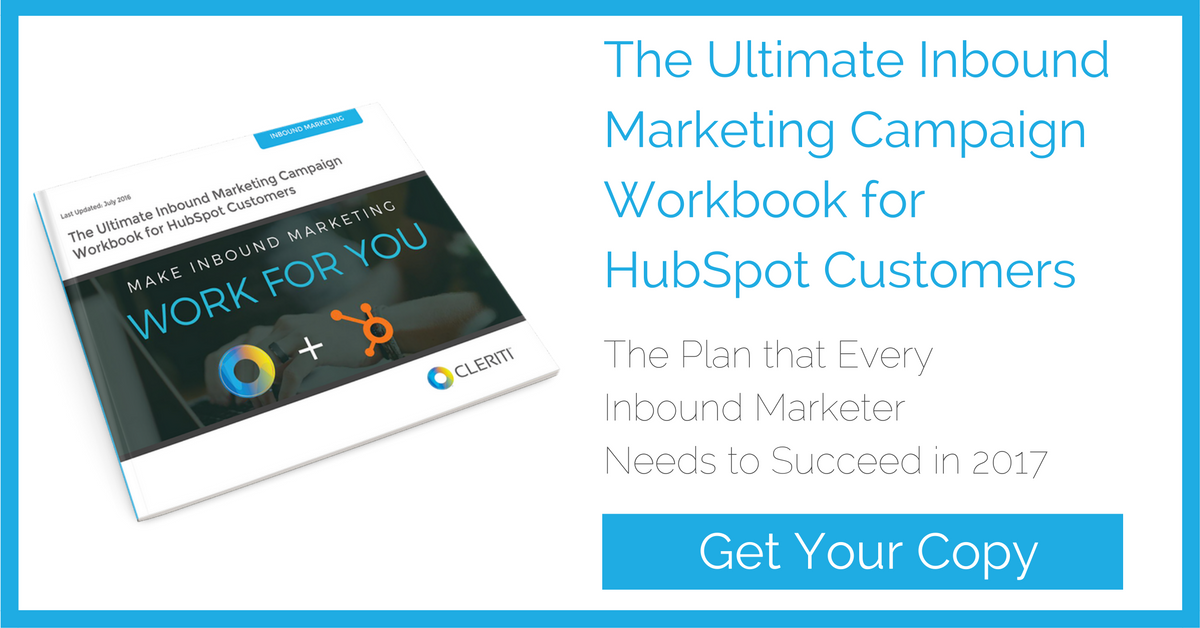- Oct 26, 2016
- By Emily Inman
- In Content Marketing
Here's What Happens When You Don't Blog for a Month
.jpg)
If you’re one of our followers, you may have noticed something odd about our content in the last month and a half. Namely, we didn’t publish a single blog. Cleriti took a content hiatus for 6 long weeks. This seems like a strange thing for an inbound marketing agency to do, given that expert blogs are one of the primary ways we help our clients build traffic and convert leads. But, for us, it was a strategic move.
One question we’re frequently asked is: “What does publishing all these blogs really do for me?”
While we know all the lines (inbound marketing activities generate more high quality leads) and are familiar with the statistics (content consumption on Linkedin increased 21% in the last 2 years ), it’s still a little difficult to offer a convincing answer when you’re always citing secondhand statistics.
So, we did our own research.
The Challenge:
Go 6 weeks without posting a single blog to see what impact it would have on our visitors and conversions.
At Cleriti, our regular content production process looks something like this:
- Our quarterly campaigns have 12 blogs on inbound marketing topics that are divvied up among our team.
- The writer for a given piece gets a reminder a week before their assignment is due.
- Assignments are turned in the day before the task is due.
- A team member edits and schedules the post.
- The content strategy team writes at least 10 social media messages that are scheduled throughout the next month or so to promote the content.
While some team members will wait until the last minute to write a piece (Confession: As a habitual procrastinator, I am one of the worst offenders), we’re fairly strict about sticking to a definite schedule so we stay on track to publish one blog on the same day each week throughout a campaign.
The Set-up:
We would need at least a full month of data in order to mine any kind of appreciable insights, but, given the way web crawlers and organic ranking work, a 4 week content drought wouldn’t be long enough to offset the years and pages of content we have accumulated to see any perceptible movement. The prospect of going 2 full months without publishing any new content, however, gave me and my fellow content strategist Jen palpable anxiety, so we split the difference and went with 6 weeks: the last week in August, all of September, and the first week in October.
On August 24, after publishing our penultimate blog for the month, we stopped production.
The Results:
Given the limited scope of the test, and the fact that we already had a significant content archive, the outcome was, as expected, less than dramatic — but still noticeable.
Organic Traffic Fell within a Normal Range of Deviation
Organic traffic naturally has a degree of variation, so having a deviation of even a hundred or so visitors from one month or another isn’t an immediate cause for alarm — though it’s often a good indication that it’s time to switch up your tactics. And the discrepancy between these two 7-week periods is well within a standard fluctuation.
7-10 — 8-27: Saw a total of 837 visitors from organic search.
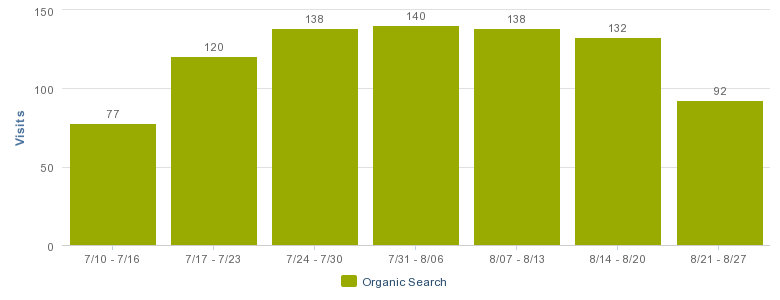
8-28 — 10-15: Saw a total of 901 visitors from organic search.
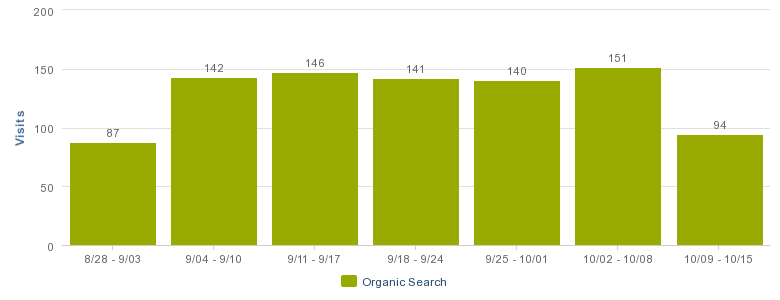 If you were to look at our performance based solely on organic traffic, you would, quite logically, come to the conclusion that blogs don’t have that great of an impact in the grand scheme of things. But that’s not the case. In fact, given the size of our content library, we expected a minimal amount of fluctuation in our organic traffic. Not so for the rest of our analytics.
If you were to look at our performance based solely on organic traffic, you would, quite logically, come to the conclusion that blogs don’t have that great of an impact in the grand scheme of things. But that’s not the case. In fact, given the size of our content library, we expected a minimal amount of fluctuation in our organic traffic. Not so for the rest of our analytics.
Our Overall Traffic Dropped a Not Insignificant Amount, though Still within the Standard Deviation
7-10 — 8/27: Saw a total of 1544 visits, 1181 excluding direct traffic (which represents those individuals who were already familiar with us).
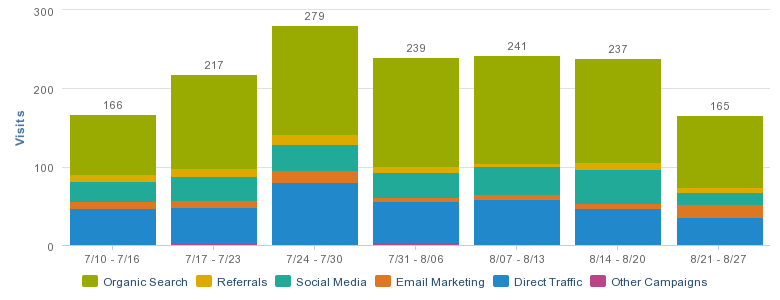
8-28 — 10-15: Saw a total of 1429 visits, 1085 excluding direct traffic.
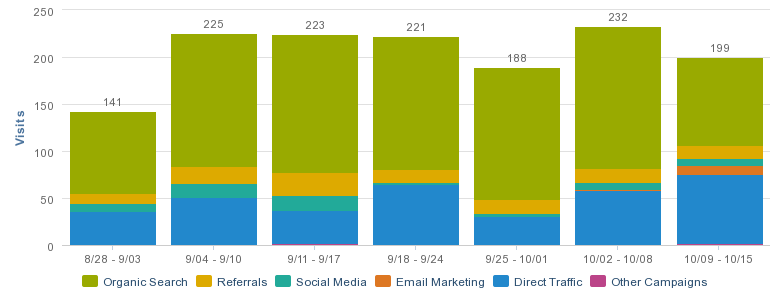
Social Traffic Saw a More Drastic Change
As social media is designed to be more of an engagement tool, a minimal part of our traffic is usually redirected from our social accounts, though this traffic is more likely to interact more with our website and content. Month-to-month differences, therefore, are felt more keenly.
In the 7-week period the stretching back from the week we published our last blog, we averaged close to 31 hits from social media a week.
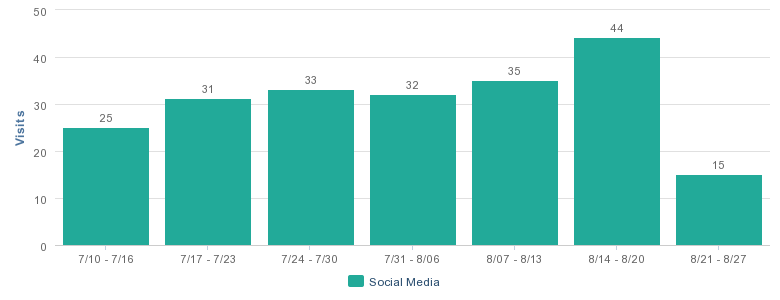
From the week after we stopped publishing new content through the week we started again, our average was fewer than 9 views a week. Our record high during this period was a little over half of our average from the previous 7 weeks — and just 1 visit more than the low from that period.
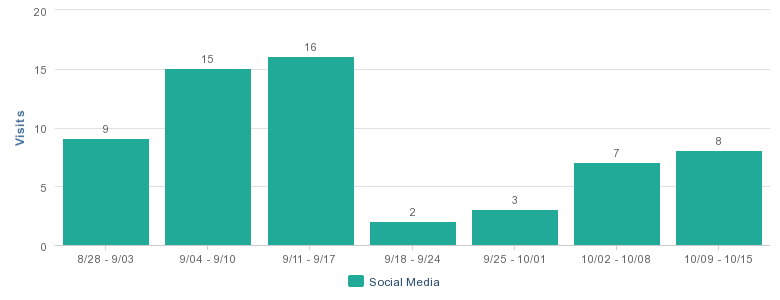
Landing Page Performance and Lead Conversion Took a Nosedive
While our overall conversion rates stayed fairly steady, the number of hits on each of our landing pages dropped dramatically.
|
7-10 — 8/27:
|
8- 28 — 10-15:
|
What We Learned
Blogs aren’t the be all and end all of inbound marketing. Yes, they’re certainly an important part of a campaign, but they can’t be the only thing in your content arsenal. If you’re just creating and publishing blogs, you may be slowly improving your search engine ranking, but that’s not what’s going to get you leads. Sure, search will keep sending traffic your way, even if you go on a 6 week hiatus, but those visitors aren’t as primed for conversion. You need to have a purpose and a strategy for getting your content in front of the eyes of the right audience.
Also, once you stop, it may not be as easy as you think to start up again. After taking a 6 week content vacation, it’s difficult to get back in the swing of things. Our hiatus atrophied our usual content production processes. Even now, three weeks after the end of our experiment, we’re still struggling to regain the rhythm we had established.



